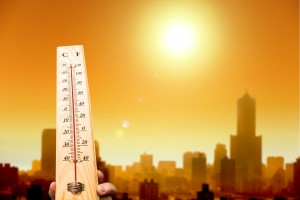7/22/16 blog post
6 tips to prevent heat exhaustion and stroke
 My phone just notified me of a heat advisory for the area, just as football and other sports are gearing up for the fall. This is a recipe for disaster. I used to do triathlons and work with athletes in Florida. I have personal experience exercising in the heat. The following information is critical for exercising outdoors during this weather.
My phone just notified me of a heat advisory for the area, just as football and other sports are gearing up for the fall. This is a recipe for disaster. I used to do triathlons and work with athletes in Florida. I have personal experience exercising in the heat. The following information is critical for exercising outdoors during this weather.
Heat exhaustion vs heat stroke
Heat exhaustion happens when the body’s natural cooling system gets tired from working hard in the heat. Symptoms include fatigue, profuse sweating, dizziness, and decreased exercise performance. When an athlete starts to notice these symptoms, it is time for a break to cool off. Sometimes 10 minutes at the water cooler is enough. Other times, they may need to seek shade or air-conditioning for several hours. They are at higher risk of getting sick again for about 24 hours.
Heat stroke happens when the body starts to shut down because it is too hot. The body’s cooling system becomes overwhelmed and stops working. If nothing is done, the person will die. An athlete with heat stroke may look like they have heat exhaustion (tired, dizzy, sometimes still sweating a lot), but they also start to have nervous system symptoms. These could be mild, like confusion or a short temper. They could be more serious, like seizures or loss of consciousness. Cooling measures should start right away, even while waiting for EMS. Cooling within 30 minutes is the best predictor of life or death. Do whatever it takes to cool them off. As heat stroke progresses, organs become damaged, sometimes permanently. This is what causes death.
6 ways to prevent heat exhaustion and stroke
- Time to adapt - The body is very good at adapting to the heat. That is how the military carries large packs in the desert. But it takes time to adapt. If your athlete is exercising outdoors in the summer, let them start with easy outdoor training sessions to give the body time to adapt. They may not be able to do their usual workouts when they move from the indoors to the outdoors. That is ok. Give it time.
- Stay hydrated – Elite athletes can sweat up to 4 liters per hour! It is not practical to drink 4 liters in an hour, so practicing good hydration all day is important. There is not a magical amount to drink, because it depends on how much you sweat. Drink until urine is colorless or very light yellow.
- Follow practice guidelines – There are set guidelines for how quickly football teams should increase the length, intensity, and frequency of football practice. They are available on the ACSM website. Follow them.
- Listen to your body – If you feel overworked, it means your body is not ready for this level of exercise in this level of heat. You either need to cool off, or ease up on the exercise, or both. Yes, you need to get in shape and adapt to the heat. But you may need to make this happen a little slower than what you are doing.
- Educate coaches – Make practice easier on the hottest days of the year (or move it indoors and make it just as hard!). Give the team unlimited access to water. Take a collapsed athlete seriously. Just because they are still sweating doesn’t mean they’re ok.
- Treat suspected heat stroke – if an athlete acts strangely while exercising in the heat, think heat stroke. Call 911 and do whatever it takes to cool them off as fast as you can. The fastest way is to place them in a tub of ice water and stir. If this is not available, other methods include dumping the cooler on them, ice packs to the neck, armpits, and groin, fans and cool wet cloths, the garden hose, and moving them indoors. Keep cooling them until EMS arrives. This is a life-or-death situation, the treatment is easily available, and the treatment is free.
Good luck to everyone out in this heat right now! Remember, a few months from now, we will be shivering in the stands at the game and wishing for some warm weather.

